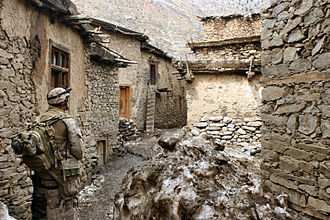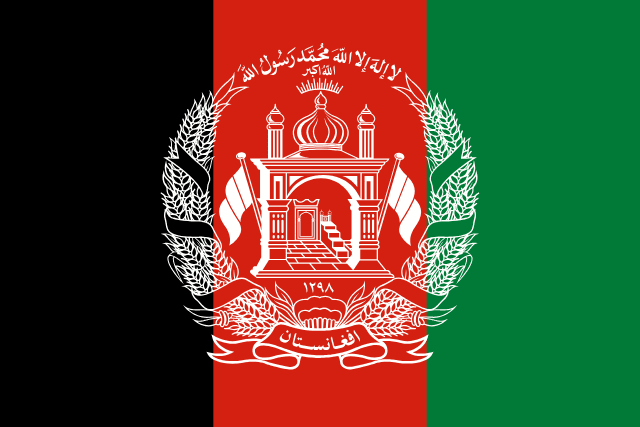Mehtar Lām travel guide in Laghman, Afghanistan
Sorry, no records were found. Please adjust your search criteria and try again.
Sorry, unable to load the Maps API.

Quick Facts:
Mihtarlam, also spelled Mehtar Lam, is the sixteenth-largest city of Afghanistan. It is the capital of Laghman Province and center of Mihtarlam District. It is the only large urban settlement in the province. The town is situated in the valley formed by the Alishang and Alingar rivers, 47 km northwest of the city of Jalalabad. There is a paved road between the cities that takes approximately one hour to travel by car.
| State/Province: | Laghman |
| Country: | Afghanistan |
| Elevation: | 795.0 m |

Complete Travel Guide to Mehtar Lām, Afghanistan
Mehtar Lām Mihtarlam, also spelled Mehtar Lam, is the sixteenth-largest city of Afghanistan. It is the capital of Laghman Province and center of Mihtarlam District. It is the only large urban settlement in the province. The town is situated in the valley formed by the Alishang and Alingar rivers, 47 km northwest of the city of Jalalabad. There is a paved road between the cities that takes approximately one hour to travel by car. Located at coordinates 34.67139°N, 70.20944°E, the city occupies a strategic position that has influenced its development throughout history. At an elevation of 795.0 meters above sea level, Mehtar Lām benefits from unique geographic advantages that distinguish it from surrounding areas. As part of Laghman province, Mehtar Lām contributes to the cultural and economic diversity that characterizes Afghanistan. The historical significance of Mehtar Lām extends beyond its current boundaries, encompassing influences that have shaped the broader region.
Historical Development of Mehtar Lām
History Amir Habibullah Khan built Qala-e-Seraj c 1912–13 in Mihtarlam On 6 February 2006, two people were killed by police in riots in Mihtarlam in events of the Jyllands-Posten Muhammad cartoons controversy.
On 26 February 2017, two students were killed and seven others wounded when a rocket landed in Shaheed Mawlawi Abdul Rahman School in Basram On 14 April 2019, at least seven children were killed when unexploded ordnance detonated in Basram on the outskirts of Mihtarlam.
Local officials spent 22 million Afs to rebuild Qala-e-Seraj in 2020 On 2 May 2020, a motorbike bomb exploded outside the provincial prison in Mihtarlam, killing three civilians and injuring four members of the Afghan security forces.
Noor Mohammad, director of Laghman’s provincial prison directorate, was among the injured On 5 October 2020, Provincial Governor of Laghman, Rahmatullah Yarmal, was slightly wounded after his convoy was targeted by a suicide car bomber.
On 24 May 2021, Afghan government forces clashed with Taliban militants in Mihtarlam “Qalat us-Seraj Palace, Mehtarlam, Laghman | ACKU Images System” Freeman, Simon (6 February 2006) “First deaths in Muhammad cartoon protests”.
Archived from the original on 13 January 2008 Retrieved 13 June 2015 “Two Students Killed As Rocket Hits School In Laghman” Retrieved 1 March 2021 “Explosion in Afghanistan’s Laghman province leaves 7 children dead”.
_Times of Islamabad_ Retrieved 1 March 2021 “Explosion In Eastern Afghanistan Leaves Seven Children Dead” Retrieved 1 March 2021 “TOLOnews status” “Archaeologists and residents in the eastern province of #Laghman said on Monday that the restoration of the historically-significant Seraj Castle (Qala -e- Seraj), which started two years ago, has been completed.
“Seraj Castle Restoration Completed” “Three killed, four injured in blast outside Afghanistan’s Laghman prison” “Afghan governor left injured after being targeted by suicide bomber” “Afghan Army, Taliban Clash Close To Kabul”.
Retrieved 3 July 2021.
The historical legacy of Mehtar Lām continues to influence contemporary life through preserved traditions, architectural heritage, and cultural practices that connect current residents to their ancestral heritage. Understanding this historical context enhances appreciation for the depth and authenticity of experiences available to visitors.
Geographic Setting and Natural Environment
The topographical characteristics of Mehtar Lām result from complex geological processes that have shaped the landscape over millennia. These natural features create distinct microclimates and ecological zones that support diverse plant and animal communities while influencing human settlement patterns and agricultural practices.
Water resources in the Mehtar Lām region play crucial roles in supporting both natural ecosystems and human communities. Rivers, springs, and seasonal water sources have historically determined settlement locations and continue to influence agricultural productivity and urban development patterns.
The relationship between geography and human activity in Mehtar Lām demonstrates sophisticated adaptation strategies developed over centuries of habitation. Local communities have learned to work with natural constraints while maximizing the advantages provided by the unique geographic setting.
Seasonal changes in the geographic character of Mehtar Lām create varying opportunities for agricultural production, transportation, and outdoor activities. Understanding these seasonal patterns helps visitors appreciate the dynamic relationship between human communities and their natural environment.
Climate Patterns and Seasonal Characteristics
Climate Mihtarlam has a cold semi-arid climate (Köppen climate classification _BSk_).
The climate of Mehtar Lām reflects the complex interaction of geographic location, elevation, and regional weather patterns that create distinct seasonal characteristics. These climatic conditions have profoundly influenced local architecture, agricultural practices, and cultural traditions throughout the region’s history.
Temperature variations throughout the year in Mehtar Lām create distinct seasons that influence both natural ecosystems and human activities. Local communities have developed sophisticated strategies for adapting to these seasonal changes, creating cultural practices and economic activities that take advantage of favorable conditions while preparing for challenging periods.
Precipitation patterns in Mehtar Lām determine agricultural cycles and water availability that support both urban and rural communities. Understanding these patterns helps explain the timing of traditional festivals, agricultural activities, and seasonal migrations that have characterized life in the region for generations.
The interaction between climate and culture in Mehtar Lām provides fascinating insights into human adaptation and environmental stewardship. Traditional building techniques, clothing styles, food preservation methods, and seasonal celebrations all reflect centuries of accumulated wisdom about living successfully in the local climatic conditions.
Cultural Heritage and Community Life
The cultural landscape of Mehtar Lām represents a living repository of traditions, customs, and social practices that have evolved over centuries while maintaining their essential character and community significance. This cultural continuity provides visitors with authentic opportunities to witness traditional ways of life that have largely disappeared from more commercialized destinations.
Social organization in Mehtar Lām reflects sophisticated systems for maintaining community cohesion and mutual support that have enabled the population to survive and thrive despite historical challenges and changing circumstances. These social structures demonstrate the resilience and adaptability that characterize local cultural traditions.
Traditional arts and crafts in Mehtar Lām continue to flourish as both cultural expressions and economic activities, providing visitors with opportunities to observe skilled artisans practicing techniques passed down through family lines for generations. These traditional skills serve as important markers of cultural identity while adapting to contemporary market demands.
Religious and spiritual practices in Mehtar Lām provide insights into the deeper values and beliefs that guide daily life and community decision-making. These traditions create frameworks for social interaction and cultural continuity that visitors can observe and appreciate through respectful participation in community activities.
Economic Activities and Local Industries
The economic structure of Mehtar Lām reflects a complex balance between traditional livelihoods and modern opportunities that enables the community to maintain economic stability while preserving cultural values and environmental sustainability. This economic diversity provides resilience against external economic pressures while supporting local community needs.
Traditional economic activities in Mehtar Lām often center around sustainable resource management practices that have been refined over generations to maximize productivity while maintaining environmental balance. These traditional approaches offer valuable lessons in sustainable development that remain relevant in contemporary discussions about economic and environmental policy.
Local markets and commercial activities in Mehtar Lām serve as important centers of community life where economic transactions intersect with social interaction and cultural exchange. These markets provide visitors with opportunities to observe traditional trading practices while supporting local entrepreneurs and artisans.
The service sector in Mehtar Lām has evolved to accommodate visitors and external economic connections while maintaining authentic community character and traditional approaches to hospitality and customer service. This balance creates opportunities for meaningful economic exchange that benefits both local communities and visitors.
Transportation and Access to Mehtar Lām
Transportation infrastructure serving Mehtar Lām reflects the balance between accessibility and preservation of community character that characterizes development throughout the region. Road networks, public transportation options, and traditional travel methods create multiple ways for visitors to reach and explore Mehtar Lām while respecting local customs and environmental considerations.
Planning Your Visit to Mehtar Lām
Successful visits to Mehtar Lām require preparation that goes beyond typical travel planning, as this destination rewards visitors who approach it with cultural sensitivity, environmental awareness, and genuine interest in learning from local communities. The most meaningful experiences in Mehtar Lām often emerge from patient observation, respectful participation, and willingness to adapt expectations to local customs and conditions.
The rewards of visiting Mehtar Lām extend far beyond the duration of your stay, as the insights gained from experiencing authentic traditional culture often influence perspectives and values long after returning home. Many visitors describe their time in Mehtar Lām as transformative, providing new understanding of human potential, community cooperation, and sustainable living practices that remain relevant in contemporary global discussions.
Source: This article incorporates material from the Wikipedia article “Mihtarlam”.
Explore Local Services in Mehtar Lām
Now that you’ve learned about Mehtar Lām, find the best local businesses, services, and attractions.
Sorry, no records were found. Please adjust your search criteria and try again.
Sorry, unable to load the Maps API.
wea

